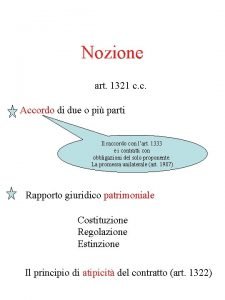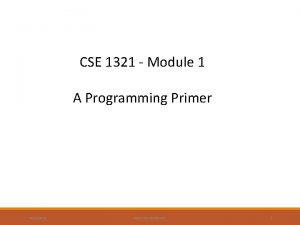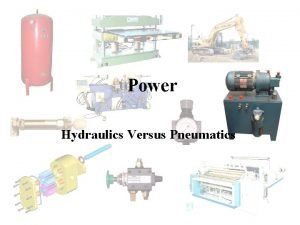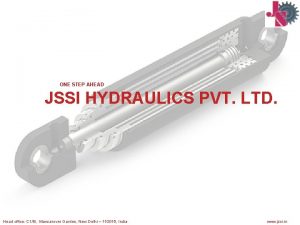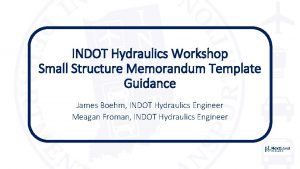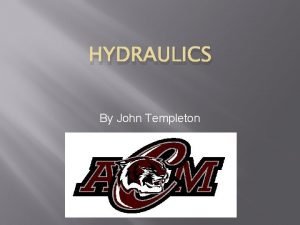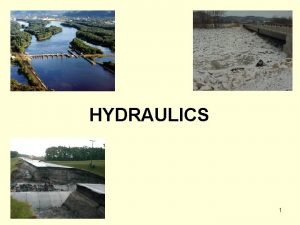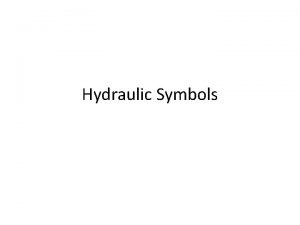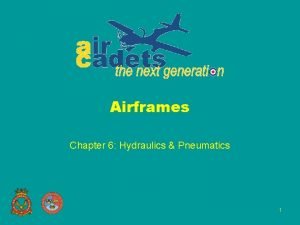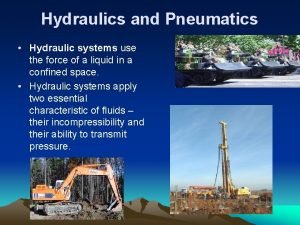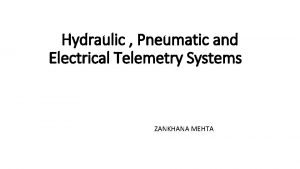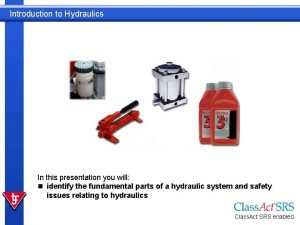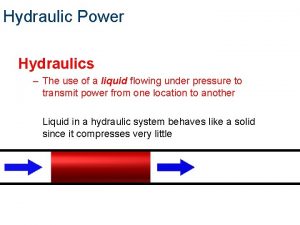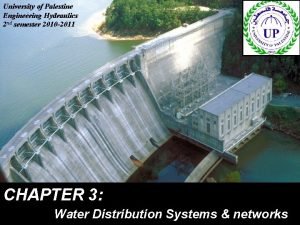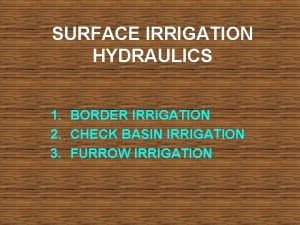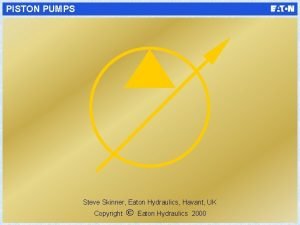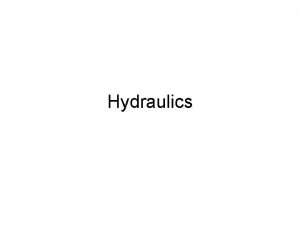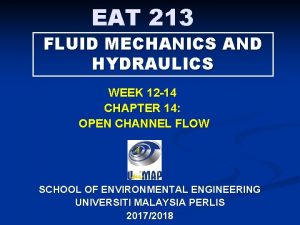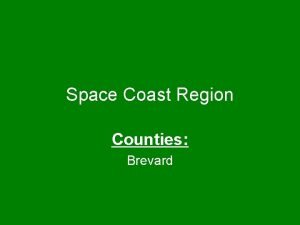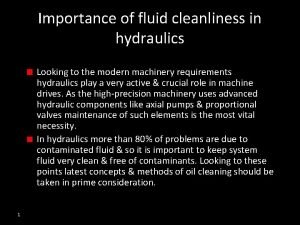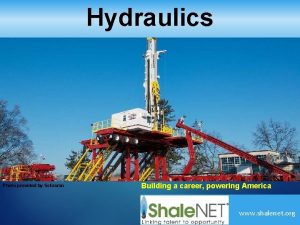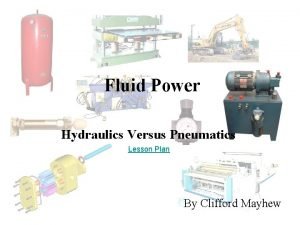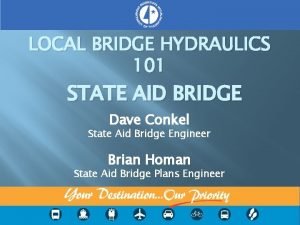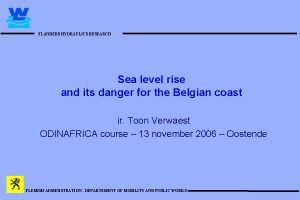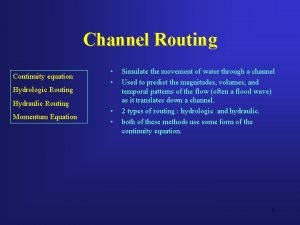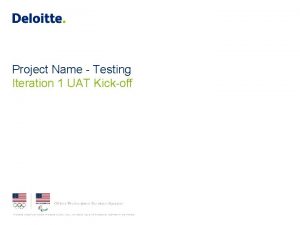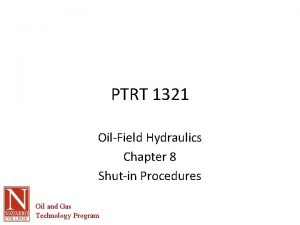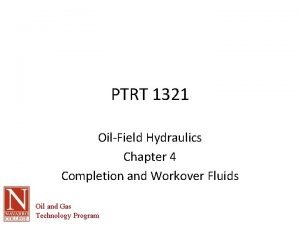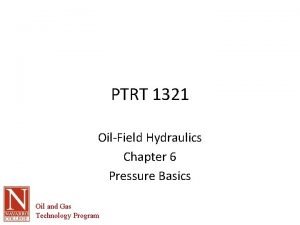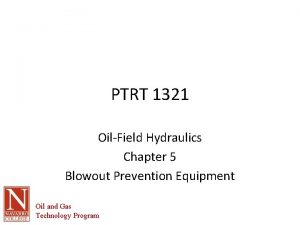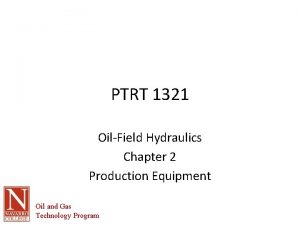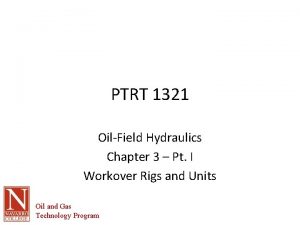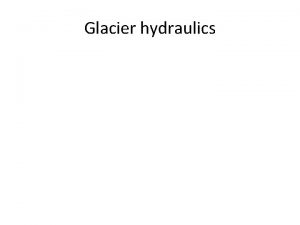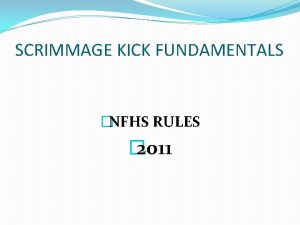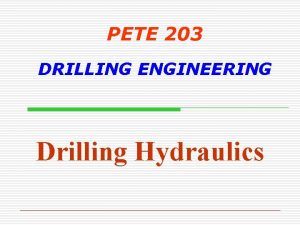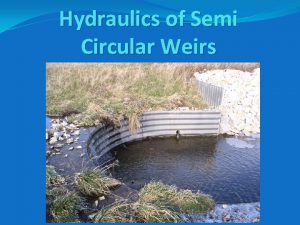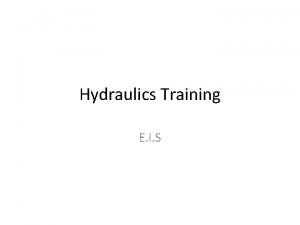PTRT 1321 OilField Hydraulics Chapter 7 Kick Fundamentals













































- Slides: 45

PTRT 1321 Oil-Field Hydraulics Chapter 7 Kick Fundamentals Oil and Gas Technology Program

Kick Fundamentals • Kick – unwanted flow of formation fluids into the wellbore • If recognized it can be handled in a controlled manner • If not recognized it can become uncontrollable – blowout • Harmful to personnel, equipment, environment • Wastes valuable reservoir energy Oil and Gas Technology Program

Causes of Kicks • Hydrostatic pressure is LESS than the formation pressure in a permeable formation open to the wellbore • Primary means of control is to maintain correct hydrostatic pressure • During drilling, completion or workover changes can occur that allow the formation pressure to exceed the hydrostatic pressure • Awareness of the possibility and then understanding of actions necessary to control the kick are important Oil and Gas Technology Program

Causes of Kicks • • • Insufficient fluid weight Inadequate fluid level in wellbore Swabbing Surging Lost circulation Abnormal pressure Obstructions in the wellbore Equipment failure Human error Oil and Gas Technology Program

Insufficient Fluid Weight • During completion and workover the weight of the circulating fluid is the primary means of controlling a well • During remedial activities fluid density can become low for several reasons – Replacing one fluid for another, e. g. brine for a fracturing or acid job being replaced with a packer fluid – Excess rainwater if entering the circulating system can greatly affect the fluid density – Sometimes the density is intentionally decreased and must be done prudently Oil and Gas Technology Program

Failure to Maintain Fluid Levels • Tripping pipe can cause the level of fluid to drop since the metal was displacing fluid while in the hole • This displaced fluid must be replaced as the pipe is removed – monitoring volume helps determine if formation fluids have entered the well • Find pipe information in many places – Halliburton Red Book – e. Red. Book – Appendix B of the text Oil and Gas Technology Program

Pressure Lost pulling wet string Oil and Gas Technology Program

Example: /ft • Each 90 -ft stand of drill pipe generates about a 25 psi drop in pressure (0. 27 x 90 = 24. 3 psi) • Some regs require that the well be filled after five stands have been pulled, or when the well has lost 75 psi whichever comes first Oil and Gas Technology Program

Pulling the String Dry Oil and Gas Technology Program

Example: /ft • Note that perhaps 13 or 14 stands of pipe can be removed prior to hitting the 75 psi requirement Oil and Gas Technology Program

Effect of Wellbore • Small wellbore should generally be refilled more often than a larger well bore = maximum length of workstring that can be pulled, ft = desired pressure drop, psi (75 psi in many cases) = fluid weight, ppg = annular capacity, bbl/ft = work string displacement, bbl/ft Oil and Gas Technology Program

Example: • Appendix B has capacities and displacements for several sizes of drill pipe, casing and hole dimensions • Halliburton Red Book is another good source of information Oil and Gas Technology Program

In class Exercise (Use Appendix B) • Determine how many feet of drill collar may be removed without exceeding 75 psi if you are using 5” drill collar in an 7⅞” hole • Assume you are using brine with a fluid weight of 11 ppg • Note: If a kick occurs while tripping pipe most operators suggest that the pipe be run back into the hole after the well is shut in to provide initial control – strip the pipe back in under pressure Oil and Gas Technology Program

Swabbing • Inability of fluid to fall past the tubing fast enough as it’s being pulled • Swabbing is more likely if: – Tubing is pulled too fast – Using high viscosity or high gel fluids – Balled-up bit (like the rubber gasket on a syringe) – Plugged work string – Thick wall cake in uncased hole – Small clearances between string and wellbore • Swabbing most often occurs when you first move the string off bottom Oil and Gas Technology Program

Safety (Trip) Margin • Additional fluid added to compensate for swabbing • Note that this equation is related to Eq. 9 on page 6 -4 for hydrostatic pressure Oil and Gas Technology Program

Example Oil and Gas Technology Program

Alternate Calculation using Yield Point of Fluid Oil and Gas Technology Program

Example Oil and Gas Technology Program

Surging • Increase in wellbore pressure that occurs during downward movement of pipe (still caused by the fluid not being able to get out of the way • Minimize surging by: – Run in at slow rates – Keep fluid in good condition (minimize viscosity and gel strength) – Break circulation periodically while running pipe into the well – Make sure volume in equals volume out – Avoid small clearances Oil and Gas Technology Program

Pressure due to Gel Strength Oil and Gas Technology Program

Example: Oil and Gas Technology Program

Lost Circulation • Fluid loss can upset the balance between hydrostatic pressure and formation pressure • Formation fracture is one of the causes of lost circulation and this possibility should always be kept in mind • Formation strength related to weight of overburden and the pressure of the fluid in the pores • Fracture can result in a kick • Lost circulation can also occur even when fracture pressure is not exceeded due to formations that are: – – – Cavernous Faulted Vuggy (holes larger than a pore but too small for a person) Jointed fissured Oil and Gas Technology Program

Abnormal Pressure • Usually used to describe pressures in excess of those expected by a column of fluid of the same depth as the formation • Low pressures are referred to as subnormal • Normal is typically = 9 ppg or 0. 465 psi/ft • Can be caused by – Salt domes – Faulted structures – Underground blowouts that charge other formations penetrated by the wellbore – Uplift and erosion • If sand or shale deposits were formed so quickly that connate water could not escape • Well logging or Measurement While Drilling(MWD) techniques can detect and predict such abnormal pressure zones Oil and Gas Technology Program

Obstructions in the Wellbore • Obstructions such as a packer or a plug can trap pressure below the obstruction • Suppose a well that was plugged and abandoned is now being redrilled • 7000 ft TVD and Formation Pressure of 2, 694 psi (equivalent FW = 7. 4 ppg) • Plug is set at 2, 000 ft TVD and is drilled through using oil emulsion mud weighing 7. 4 ppg • At 2, 000 ft this mud exerts about 770 psi • Considerable formation pressure is now exposed to only 770 psi • Even though the formation fluid will produce its own hydrostatic head from 7000 ft up to 2, 000 ft it is unlikely to completely balance the formation pressure and flow with begin Oil and Gas Technology Program

Human Error • Control can be lost due to human error, namely uncertainty as to the appropriate course of action to take • When necessary to shut in a well it must be done swiftly, without hesitation • No time should be taken for second opinions, if doubt exists then shut in the well • Most operators recommend and many regs require that crews be trained in the proper procedures for shutting in a well • Training runs and crew rotation is important so that everyone learns the appropriate steps to take when needed Oil and Gas Technology Program

Predicting Formation Pressures • Avoiding a kick is best accomplished with fluid in the wellbore that is dense enough to control formation pressure but light enough to prevent lost circulation • Helpful to know the formation pressures ahead of time • Pressures can be predicted using geologic, seismic and historical data combined with wireline logs of the well Oil and Gas Technology Program

Geologic Data • Faults – can trap formation fluids and allow abnormal pressures to develop. Pressures can change abruptly across the fault • Large structures – domes or anticlines can have abnormal pressures above the oil-water or gaswater contact because of the density differences. Abnormal pressures can often also be seen in the reservoir beds • Massive shale beds – pressures should be expected to rise abnormally with depth in thick shale beds. Watch for transition zones in which the pressure will begin to depart from normal Oil and Gas Technology Program

Geologic Data • Massive Salt Beds – plastic flow transmits overburden pressure to the rock below resulting in high pressure in and below the salt bed. 16 -19 ppg may be required • Charged sands – pressure from an underground blowout escapes into a shallow sand bed pressurizing it. When a new well is drilled through the same bed it will experience abnormal pressures Oil and Gas Technology Program

Other Sources of Data • Seismic – deduce the shape and extent of subsurface formations. Predictions regarding abnormal pressures can then be made • Historical – mud records and drilling reports from other wells drilled in the same area can give a good indication regarding the likelihood of abnormal pressures • Logging – electric or induction log can indicate pressurized shale having more water than normally pressurized shale – Acoustic or sonic logs can also indicate high-pressure shale since speed of sound is slower because of the water in them – Density log (nuclear) can also indicate high pressure shale since it is less dense than normally pressurized shale Oil and Gas Technology Program

Kick Warning Signs • • • Gain in pit volume Increase in fluid return rate Well not taking proper fluid volume during trips Drilling rate change Decrease in circulating pressure or an increase in pump strokes Change in trip, connection, or background gas Gas-cut fluid, water-cut fluid or chloride change Appearance of shale at the surface (cuttings) Well flows when the pump is shut down Change in rheology (viscosity, flow properties) of the returning fluids Oil and Gas Technology Program

Pit Gain • Pit gain is sure evidence that circulating fluid is being displaced by formation fluid • Pit are all at the same level when fluid is not being circulated • Suction pit drops most and pit nearest the return increases the most • Pit-level indicating device combines the volume contained in each pit (totalize) and displays it as a single indication Oil and Gas Technology Program

Pit Gain (cont) • Rate of pit gain can be an indication of the permeability of the kicking formation • High-permeability – Rapid flow of fluid – Fast pit level rise – Fluid not gas-cut until a considerable volume of fluid flows from the well – Flow can start as the formation is penetrated – Kick can be sudden and very dangerous – Can be difficult to detect if well is only slightly underbalanced – Pit gain can be very slow until the gas is near the surface – The expanding gas near the surface causes rapid unloading of the well reducing the BHP and allowing formation fluids to rapidly enter the well • During mixing and adding fluid to the pits only measured volumes should be added Oil and Gas Technology Program

Increased Flow of Fluid • Best way to monitor is with flow measuring devices • Flow check Raise the kelly above the rotary Stop the circulation pumps Check the return for flow from the well If still flowing then the well is kicking (wait for 2 or 3 minutes) – Oil-base fluid absorb gas requiring a longer wait time (perhaps 30 minutes) (1 bbl can absorb 100 Mcf of gas) – – • If the well flows with the pumps off but little or no pressure appears with the well shut in then it’s likely to only need a slight increase in fluid density • If pressures appear when the well is shut in then wellkilling procedures should be initiated Oil and Gas Technology Program

Well Not Taking the Proper Amount of Fluid • As mentioned earlier it is important to replace fluid displaced by pipe during a trip • Most accurately done with a trip tank Oil and Gas Technology Program

Pump Stroke Counter • Number of strokes to fill the well • Number of bbls required divided by pump output in bbl/stroke • Pump stroke volume can be looked up (B. 6 and B. 7 or other oilfield handbooks • Or calculated using the equations provided in the text Oil and Gas Technology Program

Duplex Pump Triplex Pump Note: There is some lag between the stroke counter and the flow meter. This means more fluid enters the well than is counter by the stroke counter. Oil and Gas Technology Program

Changes in Drilling Rate • When bit enters an overpressured formation the rate of penetration usually increases (except when it doesn’t) • Sudden increase = drilling break • Generally accepted policy is to conduct a flow check after only 2 to 4 ft penetration into the break Oil and Gas Technology Program

Changes in Pump Speed • Pressure imbalance between tubing and annulus changes circulating pressure • If gas is encountered during the rise through the annulus it will decrease the density of the annular fluid giving rise to a decrease in circulating pressure and pumping speed increases • Time for the preventer to be closed Oil and Gas Technology Program

Increase in Different Types of Gas • Gas detection analyzer – establish a baseline for the type of gas being produce • Type of gases returned can provide information on the presence of a kick • Three types of gases – Background gas – Connection gas – Trip gas Oil and Gas Technology Program

Background Gas • Small amounts of gases entrained in the cuttings can be used to establish a baseline (trend line). • Monitoring this trend can give early indication that you are penetrating new formation and a kick could occur Oil and Gas Technology Program

Connection and Trip Gas • When kelly is lifted to add a joint of pipe to the workstring swabbing can occur • When pumps are shut down the reduction of BHP can also allow formation fluids to enter the well (including gas). • Small fluid entries may not be detected by flow rate or pit volume but can be detected using a gas analyzer • Trip gas is more of the same as the workstring is pulled from the well Oil and Gas Technology Program

Gas-cut Circulating Fluid • Gas-cut fluid does not normally cause a significant reduction in BHP (because the pressure downhole keeps the volume of gas small • The gas will expand near the surface and make the fluid light at the flow line • Fluid weight should never be increased only because of gas-cut fluids Oil and Gas Technology Program

Effect of Gas-cut Fluid on BHP • Even though the fluid weight has been cut in half • The effect on BHP is only 104 psi (about 0. 5%) • The effect of gas-cut is typically less than the effect cause by shutting down the pumps and stopping circulation Oil and Gas Technology Program

Water-cut Fluid or Chloride Change • Increased formation pressures squeeze water out of the formation leaving the remaining fluids higher in salinity • Thus salinity can be expected to increase when entering an overpressurized zone • This can be seen as increases salinity in the filtrate exiting the shale shaker • If this increased salinity is not coming from the make up water the problem must be in the well • Chloride measurements indicate the level of salinity and steadily increasing chloride levels can indicate that pore pressures are also increasing Oil and Gas Technology Program

Sloughing Shale • Underbalanced conditions can cause shale to slough • Other factors can also play a role – Formation dip – Compaction – Cementing of sand grains – Internal stress • Often attributed to other sources and the possibility of abnormal pressures can be overlooked Oil and Gas Technology Program
 Spears and associates hydraulic fracturing market report
Spears and associates hydraulic fracturing market report Ddc directional drilling
Ddc directional drilling Lj trade
Lj trade Digital oilfield solution
Digital oilfield solution Hours of service logbook examples
Hours of service logbook examples 1321 cc
1321 cc Art 1321 cc
Art 1321 cc Cse 1321
Cse 1321 Ksu ccse fye
Ksu ccse fye Cse 1321
Cse 1321 1321 significado espiritual
1321 significado espiritual 1321-1265
1321-1265 Cse 1321
Cse 1321 Hydraulic versus pneumatic
Hydraulic versus pneumatic Jssi hydraulics
Jssi hydraulics Indot hydraulics
Indot hydraulics Hydraulics definition
Hydraulics definition Hydraulics definition
Hydraulics definition Pressure relief valve symbol
Pressure relief valve symbol Advantages of hydraulic
Advantages of hydraulic Pneumatics vs hydraulics
Pneumatics vs hydraulics Introduction to hydraulics and pneumatics
Introduction to hydraulics and pneumatics Pneumatic telemetry system
Pneumatic telemetry system Introduction to hydraulics and pneumatics
Introduction to hydraulics and pneumatics Hydraulics
Hydraulics Hydraulics and pneumatics quiz
Hydraulics and pneumatics quiz Palestine hydraulics
Palestine hydraulics Border hydraulics
Border hydraulics Eaton havant
Eaton havant Hydraulics
Hydraulics Hoerbiger benefits
Hoerbiger benefits Hydraulics
Hydraulics Space coast hydraulics
Space coast hydraulics Elc machine working principle
Elc machine working principle Professional hydraulics
Professional hydraulics Fluid power hydraulics and pneumatics
Fluid power hydraulics and pneumatics Hydraulics karl lagerfeld
Hydraulics karl lagerfeld Hydraulics 101
Hydraulics 101 Khan academy hydraulics
Khan academy hydraulics Flanders hydraulics research
Flanders hydraulics research Continuity equation hydrology
Continuity equation hydrology Hydraulic routing methods
Hydraulic routing methods Direct free kick signal
Direct free kick signal Kicks for life
Kicks for life Kick off møde agenda
Kick off møde agenda Uat kick off
Uat kick off





